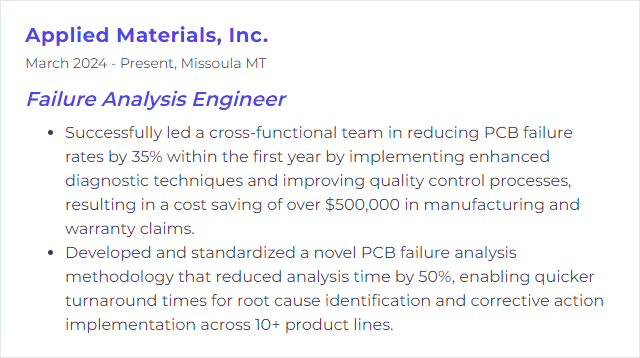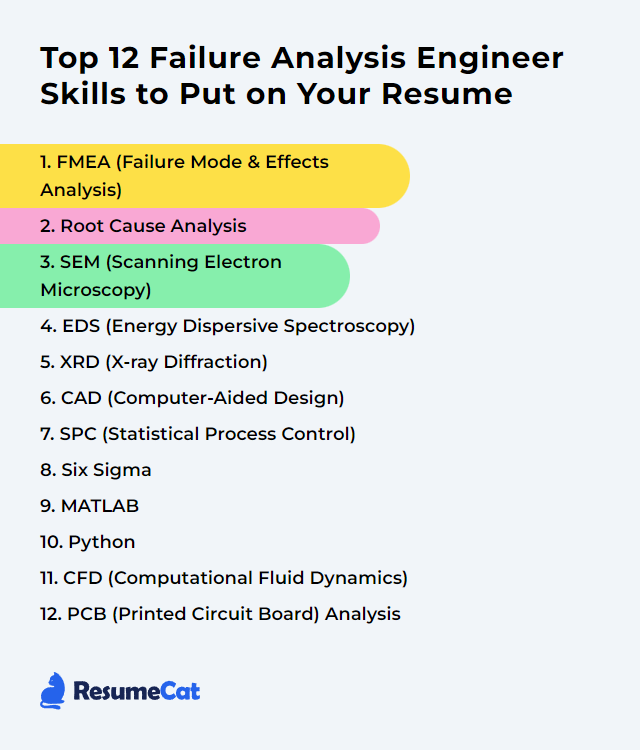Top 12 Failure Analysis Engineer Skills to Put on Your Resume
A standout resume for a Failure Analysis Engineer hinges on a sharp, targeted mix of core competencies and hands-on technical depth. You’re telling a story: you can dig into gnarly problems, trace them to their roots, and design fixes that stick. The skills below capture what hiring managers expect to see, and what peers trust in the field.
Failure Analysis Engineer Skills
- FMEA (Failure Mode and Effects Analysis)
- Root Cause Analysis
- SEM (Scanning Electron Microscopy)
- EDS (Energy Dispersive Spectroscopy)
- XRD (X-ray Diffraction)
- CAD (Computer-Aided Design)
- SPC (Statistical Process Control)
- Six Sigma
- MATLAB
- Python
- CFD (Computational Fluid Dynamics)
- PCB (Printed Circuit Board) Analysis
1. FMEA (Failure Mode and Effects Analysis)
FMEA is a structured method to surface potential failure modes in a design, process, product, or service, then prioritize actions to reduce risk. Done early and kept alive through the lifecycle, it shrinks surprises, boosts reliability, and keeps safety front and center.
Why It's Important
It forces a clear-eyed look at how things break, how bad it could be, and what to do first—so failures get prevented, not just patched.
How to Improve FMEA (Failure Mode and Effects Analysis) Skills
Use the AIAG-VDA approach: Shift from legacy RPN to Action Priority (AP). AP drives better decisions when severity is high, even if occurrence is low.
Build a cross-functional team: Design, quality, manufacturing, service. Diverse experience catches blind spots you won’t find alone.
Expand failure mode discovery: Mine field returns, warranty data, FRACAS logs, past CAPAs. Add Ishikawa diagrams and parameter diagrams to widen the net.
Make detection real: Tie detection rankings to proven test coverage, gauge R&R results, and in-process controls—not wishful thinking.
Drive concrete actions: Assign owners, deadlines, verification plans. Close the loop with evidence (test results, capability data, control plan updates).
Keep it living: Update after ECNs, supplier shifts, process tweaks, or new failure data. Treat FMEAs as control documents, not archives.
Leverage tools and training: Use platforms like XFMEA or APIS IQ-Software, plus formal training through ASQ or internal academies.
Focused, current, and action-driven FMEAs cut risk where it matters most.
How to Display FMEA (Failure Mode and Effects Analysis) Skills on Your Resume

2. Root Cause Analysis
RCA is the disciplined hunt for the underlying mechanism behind a failure. Not the symptom. The trigger. The chain.
Why It's Important
It prevents repeat issues, strengthens product reliability, and channels resources into fixes that actually change outcomes.
How to Improve Root Cause Analysis Skills
Frame the problem tightly: Who, what, where, when, how often. Time box the event. Bound the system.
Collect the right evidence: Operating conditions, logs, inspection data, environmental factors, operator notes, lot histories.
Diverge before converge: Use 5 Whys, Ishikawa, and fault tree analysis to explore mechanisms rather than jumping to pet theories.
Test hypotheses: Replicate the failure, isolate variables, instrument the system, and run controlled experiments.
Verify effectiveness: Implement corrective and preventive actions, then monitor leading indicators and lagging metrics to confirm elimination.
Document and share: Standardize reports, record learning in a knowledge base, and roll findings into FMEA, control plans, and training.
How to Display Root Cause Analysis Skills on Your Resume
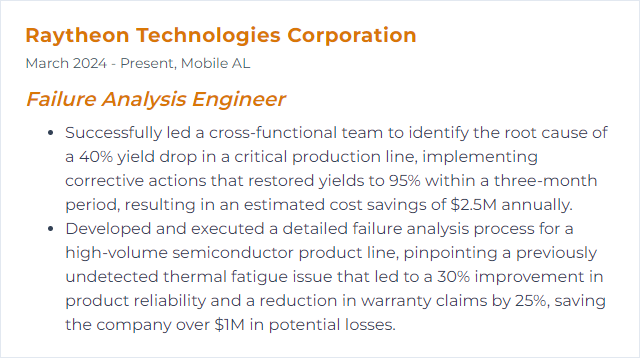
3. SEM (Scanning Electron Microscopy)
SEM provides high-resolution, high–depth-of-field imaging of surfaces and near-surface features. With the right detector setup, you can reveal topology, contrast composition, and pinpoint microfractures and wear patterns that hide from the naked eye.
Why It's Important
It exposes microstructural clues—fractography, coating defects, inclusions—that often make or break a root cause narrative.
How to Improve SEM (Scanning Electron Microscopy) Skills
Tune accelerating voltage: Lower kV for surface detail and charge-sensitive samples; higher kV for penetration and signal strength.
Pick the right detector: Secondary electrons for topography; backscattered electrons for atomic-number contrast; pair with EDS for composition.
Prep like it matters: Cleanliness, flatness, and conductivity. Consider sputter coating (Au, Pt, C) or variable-pressure modes for non-conductors.
Control charging and drift: Optimize vacuum, grounding, working distance, and beam current. Be patient with stabilization.
Use advanced techniques: EBSD for crystallography, FIB cross-sections for site-specific cuts, 3D reconstructions for depth context.
Refine images post-capture: Calibrated contrast/brightness, noise reduction, and careful annotation for reports.
How to Display SEM (Scanning Electron Microscopy) Skills on Your Resume

4. EDS (Energy Dispersive Spectroscopy)
EDS identifies and maps elemental composition by detecting characteristic X-rays generated under electron bombardment. It’s the workhorse companion to SEM in materials forensics.
Why It's Important
Contamination, off-spec alloys, plating mix-ups, diffusion issues—EDS makes them visible and quantifiable.
How to Improve EDS (Energy Dispersive Spectroscopy) Skills
Prep and cleanliness first: Remove residues, ensure good mounting, and minimize surface roughness to improve signal-to-noise.
Match settings to the task: Pick accelerating voltage for excitation of target lines; optimize working distance and takeoff angle for count rates.
Use standards and calibrate: Regular calibration and appropriate standards drive trustworthy quant results.
Mind detector limits: Understand resolution, dead time, and count rate trade-offs. Avoid pile-up. Watch for peak overlaps.
Map smartly: Combine spot, line scans, and area mapping. Correlate with BSE contrast and, when available, EBSD phase data.
Protect fragile samples: Consider cryo-techniques or low-dose conditions to reduce beam damage.
How to Display EDS (Energy Dispersive Spectroscopy) Skills on Your Resume
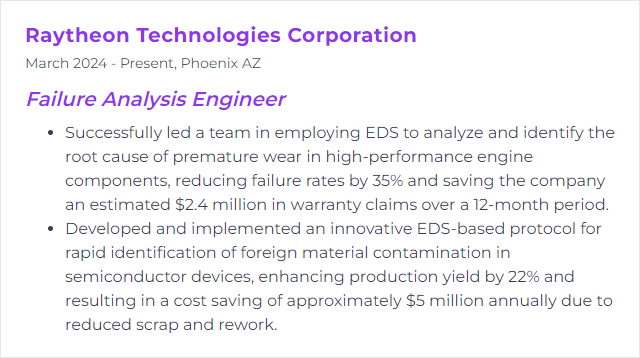
5. XRD (X-ray Diffraction)
XRD characterizes crystalline phases, lattice parameters, texture, and residual stress. In failure analysis, it clarifies what materials are truly present—and how their structure changed under stress, heat, or environment.
Why It's Important
When phase composition or stress state shifts, performance follows. XRD shows the shift.
How to Improve XRD (X-ray Diffraction) Skills
Prepare representative surfaces: Flat, uniform, and free from smeared layers. Consider careful grinding/polishing to avoid inducing artifacts.
Optimize scan parameters: Step size, scan speed, divergence slits, and 2θ range tuned to expected phases and crystallite size.
Use robust analysis: Apply peak fitting, background subtraction, and Rietveld refinement for quantitative results. Tools like TOPAS or Jade help.
Calibrate and maintain: Regular instrument checks with standards ensure accuracy over time.
Go beyond basics: Residual stress scans, grazing incidence for thin films, and texture analysis when anisotropy matters.
How to Display XRD (X-ray Diffraction) Skills on Your Resume

6. CAD (Computer-Aided Design)
CAD enables precise modeling, interrogation, and iteration of components and assemblies. Critical for tolerance analysis, fit checks, and pre-empting design-induced failures.
Why It's Important
You can test ideas quickly, quantify risk, and hand manufacturing something buildable—and resilient.
How to Improve CAD (Computer-Aided Design) Skills
Master fundamentals: Parametric modeling, constraints, assemblies, drawings. Get fast and consistent.
Tie models to physics: Use built-in simulation or export to FEA/CFD to probe stresses, deflection, and thermal behavior before metal meets machine.
Respect materials: Model with real properties and real tolerances. Feed lessons from failures back into design rules.
Standardize: Templates for drawings, GD&T schemes, and BOM structures. Clean data pays dividends.
Collaborate in context: Manage versions, track ECNs, and co-review with manufacturing and quality for smooth handoffs.
Level up: Explore advanced surfacing, lattice structures, generative design, and scripting for repetitive tasks.
How to Display CAD (Computer-Aided Design) Skills on Your Resume
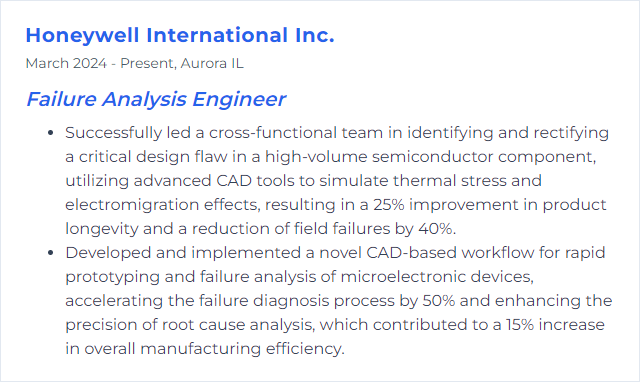
7. SPC (Statistical Process Control)
SPC tracks process behavior with statistical tools so you can detect signals, not noise. It keeps production honest and variation in check.
Why It's Important
Early warnings beat late scrambles. SPC spots drift and special causes before defects pile up.
How to Improve SPC (Statistical Process Control) Skills
Pick the right charts: X̄-R or X̄-S for subgroups, I-MR for singles, p/np/c/u for attributes. Match chart to data.
Lock data quality: Calibrated gauges, sound sampling plans, and solid MSA. Bad data, bad decisions.
Monitor capability: Track Cp/Cpk and Pp/Ppk. Tie goals to customer CTQs and regulatory limits.
Act fast on signals: Define out-of-control action plans. Combine SPC with RCA to prevent recurrence.
Go real time: Dashboards and alerts shorten response time and reduce scrap.
Bake in continuous improvement: Lean, DMAIC, and standard work to tighten processes over time.
How to Display SPC (Statistical Process Control) Skills on Your Resume
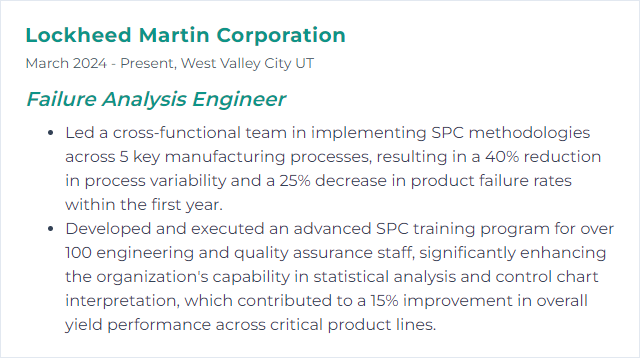
8. Six Sigma
Six Sigma is a data-centered methodology for slashing defects and variation. The DMAIC cycle—Define, Measure, Analyze, Improve, Control—structures change that lasts.
Why It's Important
It turns murky problems into measurable targets and steady gains in quality, reliability, and cost.
How to Improve Six Sigma Skills
Deepen analytics: Hone hypothesis testing, DOE, regression, and nonparametric methods. Tools like Minitab or JMP speed insight.
Automate the grunt work: Use Python or MATLAB to process large datasets, build dashboards, and generate repeatable analyses.
Strengthen RCA integration: Marry Six Sigma tools with 5 Whys, fishbone diagrams, and FMEA so improvements address root causes.
Elevate communication: Clear visuals, sharp executive summaries, and crisp change management keep stakeholders aligned.
Lean plus Six Sigma: Pair waste reduction with variation reduction for faster, cleaner processes.
Certify and mentor: Pursue Green/Black Belt, then coach others. Scaling competence multiplies impact.
How to Display Six Sigma Skills on Your Resume

9. MATLAB
MATLAB is a numerical computing environment built for analysis, modeling, and visualization. Perfect for signal and data crunching, quick simulations, and algorithm prototyping.
Why It's Important
It turns messy datasets into defensible conclusions with plots, models, and scripts you can reuse.
How to Improve MATLAB Skills
Nail the core: Vectorization, matrix operations, function handles, tables, and timetables.
Exploit toolboxes: Statistics and Machine Learning, Signal Processing, Optimization—pick what matches your failure modes.
Work with real data: Build pipelines for cleaning, feature extraction, and anomaly detection pulled from logs and sensors.
Make it interactive: Live Scripts for narrative analysis, App Designer for simple internal tools.
Verify and validate: Unit tests for key functions, benchmarking, and reproducible scripts under version control.
How to Display MATLAB Skills on Your Resume

10. Python
Python is a versatile language with a rich scientific stack—great for data munging, automation, modeling, and visualization.
Why It's Important
Pandas, NumPy, SciPy, scikit-learn, Matplotlib—together they let you ingest, analyze, predict, and present without friction.
How to Improve Python Skills
Strengthen fundamentals: Data structures, list/dict comprehensions, generators, context managers, and packaging.
Own the data stack: Pandas for wrangling, NumPy for speed, Matplotlib/Seaborn/Plotly for visuals.
Model what matters: Use SciPy and scikit-learn for regression, clustering, outlier detection, and reliability modeling.
Automate pipelines: Build ETL scripts, scheduled jobs, and notebooks for repeatability and speed.
Test and version: Pytest, pre-commit hooks, and Git. Reproducibility isn’t optional.
Practice relentlessly: Coding challenges, open-source contributions, and project work tied to actual failure datasets.
How to Display Python Skills on Your Resume
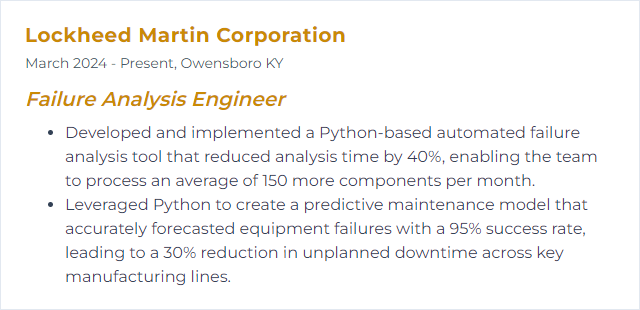
11. CFD (Computational Fluid Dynamics)
CFD simulates fluid flow, heat transfer, and related physics. In failure analysis, it reveals where pressure spikes, recirculation zones, cavitation, or thermal hotspots push systems over the edge.
Why It's Important
It explains failures that hide in motion—inside pipes, over blades, through vents, across electronics, under the hood.
How to Improve CFD (Computational Fluid Dynamics) Skills
Mesh with intent: Local refinement where gradients are steep; wall treatment matched to y+ targets. Balance accuracy with runtime.
Choose the right physics: Turbulence models (k-ω SST, LES, DES), compressibility, multiphase, conjugate heat transfer—include what matters, skip what doesn’t.
Get boundaries right: Inlet profiles, turbulence intensity, thermal loads, and material properties grounded in test data.
Verify and validate: Grid independence studies, time-step sensitivity, and comparison against experiments or benchmarks.
Scale up smartly: Use HPC when needed; profile solvers and parallel settings to cut wall time.
Automate exploration: Scripts for parametric sweeps and design optimization; couple with Python for post-processing.
How to Display CFD (Computational Fluid Dynamics) Skills on Your Resume

12. PCB (Printed Circuit Board) Analysis
PCB analysis digs into board-level failures—from solder joint fatigue and pad cratering to trace opens, via defects, and component damage—so electronics stay robust in the field.
Why It's Important
Boards are dense ecosystems. One tiny defect can cascade into intermittent bugs, thermal runaway, or total loss.
How to Improve PCB (Printed Circuit Board) Analysis Skills
Start with optics: High-magnification visual inspection and AOI catch many surface defects before you cut anything.
Use non-destructive testing: X-ray for BGA voids, solder fillets, hidden joints, and internal layer alignment.
Go microstructural when needed: Cross-section (microsectioning) to expose vias, traces, and intermetallics; SEM/EDS for fracture surfaces and contaminants.
Run electrical diagnostics: In-circuit test, flying probe, boundary scan, and functional test under realistic loads.
Control the process window: Validate reflow profiles, flux chemistry, cleanliness (ionic contamination), and handling practices.
Design for reliability: Check creepage/clearance, controlled impedance, thermal relief, and via-in-pad rules against IPC guidance.
Simulate early: SI/PI and thermal simulation to preempt crosstalk, IR drop, and hot spots.
Close the loop: Feed findings to suppliers, update DFM/DFA rules, and reflect changes in FMEA and control plans.
How to Display PCB (Printed Circuit Board) Analysis Skills on Your Resume
